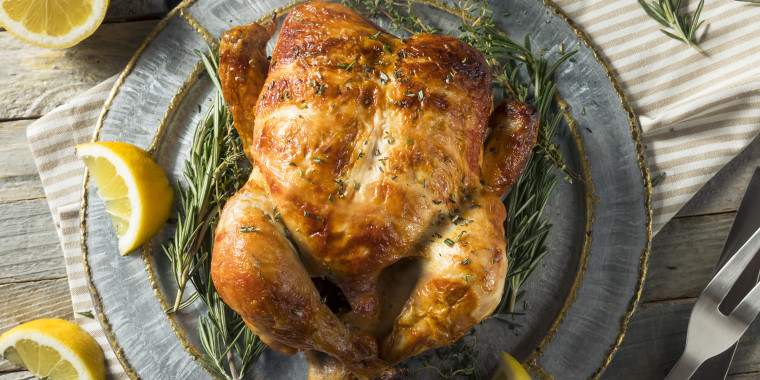Busy nights happen to everyone. Yet while many of us know that cooking a meal from scratch is often the best solution to ensure a healthful, well-balanced dish is being served, sometimes turning on the stove or oven is really just too much work after a long day.
Enter the rotisserie chicken. It's budget friendly (often around $7 for a whole chicken), versatile, available almost everywhere and great on its own, on top of salad greens, or thrown into some leftover soup or pasta. But is snapping up a cheap chicken actually healthy?
It depends, say food industry experts and nutritionists. There are several important factors to consider when shopping for a bird. Here are five easy things to note when buying a rotisserie chicken.
1. Is it fresh?
Sometimes it's hard to tell just how long those chickens have been sitting in a supermarket display case, but that shouldn't stop you from taking a closer look at the label before you pick up any old bird. “You want to be sure you’re choosing chickens that are fresh and that they haven’t been spinning around on those rotisseries for hours,” Bonnie Taub-Dix, RDN, creator of BetterThanDieting.com, author of "Read It Before You Eat It - Taking You from Label to Table," told TODAY Food.
You probably wouldn't buy a container of milk past its best-by date, so prepared foods shouldn't be any different. If there's no date on the chicken's packaging then just ask. “If they’re already displayed in a fridge [or warming tray] ... you can check with a [store] manager to see when they were put out. People in stores like Costco line up to wait for those chickens to get done,” said Taub-Dix.
If the bird looks slimy or smells off, then don't buy it.
2. Check out all of the ingredients
When you're making a chicken at home, you can control the spices and salt added to it. In a supermarket, things get more complicated.
Many chickens, like the ones sold at Costco, are treated with seasonings that contain sodium phosphate, modified food starches, potato dextrin, carrageenan [a thickening agent] and sugars. While all of these additives are recognized as safe to consume by the Federal Drug Administration (FDA) many chefs advise opting for ones without if you're concerned about preservatives in your diet.
"The most common types of modified food starch are made from ingredients like genetically engineered corn [or] wheat," Liana Werner-Gray, founder of The Earth Diet and healthy eating advocate, told TODAY. If you or anyone in your family has a gluten sensitivity, double check the ingredients with someone working at the prepared foods counter. Starches, said the chef, are used to make the chicken skin thicker and help the seasonings adhere better to the skin.
3. Has it been cooked correctly?
Undercooked poultry should never be consumed, so always take a moment to inspect a rotisserie chicken before you eat it. "If it's white, it's fully cooked. If any parts appear pinkish it can be undercooked," said Werner-Grey. When they get home, consumers "can also tell by how you tear the chicken from the bone. If it has a raw texture and sounds like flesh tearing, it is undercooked." If you've already purchased the bird and notice that it's undercooked, better to be safe than sorry and take it back to the store for a fully cooked one.
Of course, you don't want a well-done chicken, either. "If the rotisserie chicken is overcooked it will have a green or grey, or grey-green color to the meat," said the chef.
4. Where is the chicken from?
Unless you're buying the chicken from an organic grocer, there's a good chance that it was raised with antibiotics. While an organic chicken isn't more nutritious than a conventionally raised one, if you're concerned about animal welfare, consider where you're buying the rotisserie chicken in the first place.
"When an animal is raised with room to roam, it's more ethically treated and tastes better," chef Tim Kemp of Blue Apron's culinary team, told TODAY. Though taste is subjective, Werner-Grey also agreed that avoiding as many additives as possible allows any food's true taste to shine.
5. Scan for sodium
Most rotisserie chickens have some sort of marinade, glaze and/or spice mix used to flavor the chicken. While those seasonings (which may range from barbecue to zesty Italian, lemon-herb or even cajun) are what makes the protein taste so good, many of them are loaded with sodium.
"I recommend that you take off the skin to avoid further fat consumption," said Jessica Mantell, a nutritionist at 54D fitness center in Miami. "It [the skin] also contains a lot of preservatives ... sometimes it could be as much as 1/2 of your daily recommended sodium intake."
But how much salt is too much? Many fresh rotisserie chickens don’t have nutrition labels but a "3-ounce serving [the size of a deck of cards] of rotisserie chicken could have more than 600 milligrams of sodium," Taub-Dix said. Considering that most healthy people should consume no more than 2,300 milligrams of sodium every day, she added that it's especially important to stay within this portion guideline when eating a chicken you didn't make yourself.



